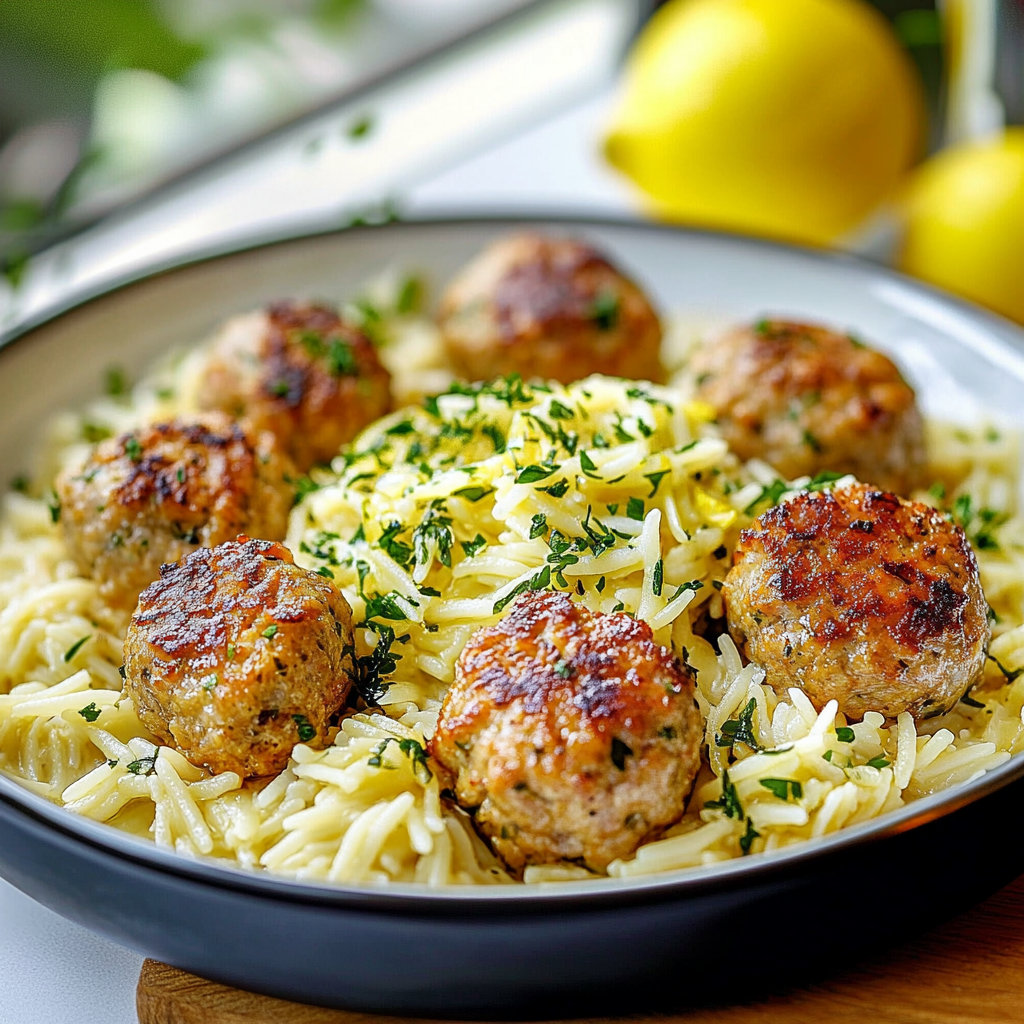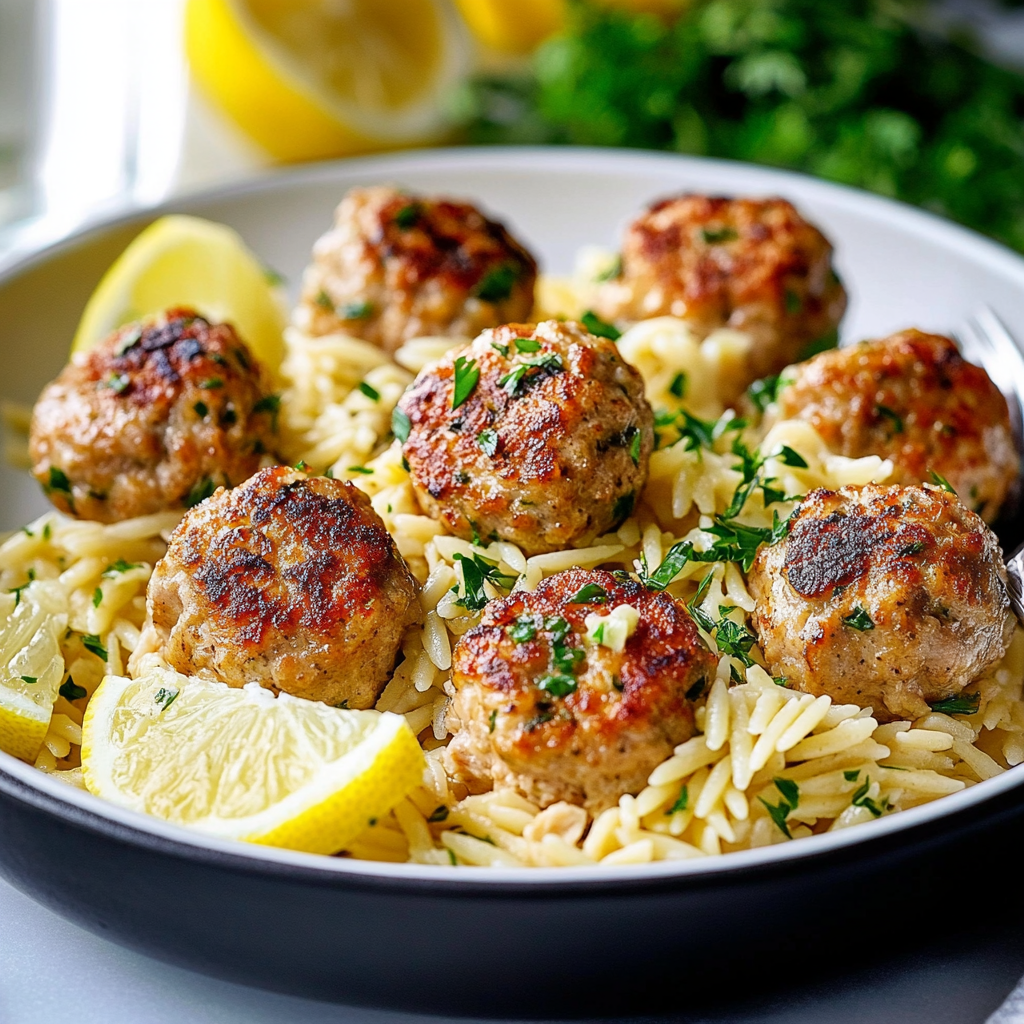Quick Overview
If you’re seeking a delightful dish that combines savory flavors and fresh ingredients, look no further than Greek Chicken Meatballs with Lemon Orzo. This recipe perfectly marries the tender juiciness of chicken meatballs infused with Mediterranean spices and the refreshing zest of lemon orzo. Ideal for family dinners or gatherings with friends, this dish is not only satisfying but also easy to prepare. The combination of aromatic herbs like oregano and dill in the meatballs adds depth to their flavor profile while the lemon orzo provides a bright contrast. As you dive into this recipe, you’ll find that it’s perfect for anyone who enjoys wholesome meals that transport you straight to the sunny shores of Greece. Let’s get started on creating this delicious culinary experience that will leave your taste buds craving more.
Ingredient Breakdown
1. Ground Chicken (1 pound)
Ground chicken serves as the main protein source for the meatballs. It is leaner than beef or pork and absorbs flavors well.
2. Breadcrumbs (¾ cup)
Breadcrumbs help bind the meatballs together and maintain their moisture during cooking. Use plain or seasoned varieties based on your preference.
3. Feta Cheese (½ cup)
Crumbled feta cheese adds a creamy texture and tangy flavor to the meatballs. It enhances their overall taste and gives them an authentic Greek touch.
4. Garlic (3 cloves, minced)
Fresh garlic lends a robust aroma and flavor to the dish. It complements the other ingredients perfectly and infuses each bite.
5. Dried Oregano (1 teaspoon)
Oregano is a staple in Greek cuisine. Its earthy flavor brings warmth and depth to the chicken meatballs.
6. Fresh Dill (2 tablespoons, chopped)
Dill adds a bright herbaceous note that balances out the richness of the feta cheese in the meatballs.
7. Egg (1 large)
An egg acts as a binder for the ingredients, ensuring that the meatballs hold their shape while cooking.
8. Salt and Pepper (to taste)
Seasoning is crucial; salt enhances all flavors while pepper provides a subtle heat.
9. Orzo Pasta (1 cup)
This small pasta shape serves as a base for serving alongside the chicken meatballs and absorbs all the delicious flavors from the sauce.
10. Lemon Juice (from 1 lemon)
Fresh lemon juice brightens up both the orzo and meatball flavors while adding acidity that elevates each component of this dish.
11. Chicken Broth (2 cups)
Used for cooking the orzo, chicken broth infuses it with rich flavor, enhancing its taste significantly compared to using water alone.
Step By Step Recipe: Greek Chicken Meatballs with Lemon Orzo
1. Preheat your oven to 400°F (200°C). Prepare a baking sheet by lining it with parchment paper or lightly greasing it to prevent sticking.
2. In a large mixing bowl, combine ground chicken, breadcrumbs, crumbled feta cheese, minced garlic, dried oregano, fresh dill, egg, salt, and pepper. Mix until just combined; avoid overmixing for tender meatballs.
3. Use your hands to form small balls from the mixture—about 1 inch in diameter—and place them on your prepared baking sheet evenly spaced apart.
4. Bake in preheated oven for 20-25 minutes until golden brown and cooked through; internal temperature should reach 165°F (74°C).
5. While baking the meatballs, bring 2 cups of chicken broth to a boil in a medium saucepan over high heat; stir in orzo pasta once boiling.
6. Cook orzo according to package instructions until al dente—about 8-10 minutes—then drain any excess liquid if necessary.
7. Once cooked, stir in freshly squeezed lemon juice into the warm orzo along with additional salt and pepper if desired; mix well to combine flavors evenly.
8. Serve baked chicken meatballs over lemon-infused orzo; garnish with extra dill or crumbled feta if desired for added presentation.
Serving and Storing Tips
Serving Suggestions
These Greek Chicken Meatballs with Lemon Orzo are best enjoyed immediately after preparation when they are at their freshest and most flavorful. Serve them warm on individual plates topped with extra feta cheese or fresh herbs for an appealing presentation. Pair this dish with a side of tzatziki sauce for dipping or drizzle olive oil over everything for added richness—a simple green salad also complements it nicely!
Storage Guidelines
To store leftovers safely after enjoying your meal, allow both components—meatballs and orzo—to cool down completely at room temperature before transferring them into airtight containers separately; this helps prevent sogginess in storage. They can be refrigerated for up to three days without losing quality; simply reheat gently before serving again! If you want longer storage options available after making too much food ahead of time consider freezing either item individually as well—frozen portions can last up to three months!
Mistakes to avoid
One common mistake when making Greek Chicken Meatballs with Lemon Orzo is overmixing the meat. When you combine the ingredients too much, the meatballs can become dense and tough. Instead, gently mix the ground chicken with herbs and spices until just combined. This will help maintain a tender texture.
Another mistake is not letting the meatballs rest before cooking. Allowing them to sit for about 15 minutes after forming helps them hold their shape better during cooking. If you skip this step, they may fall apart in the pan or while baking.
Using too much liquid in your lemon orzo can lead to a mushy texture. Make sure to measure your broth carefully and follow the recommended cooking times. If necessary, adjust the liquid based on how your orzo absorbs it.
Not seasoning adequately is another issue that often arises. Chicken can be bland if not properly seasoned. Be generous with salt, pepper, and herbs to ensure your Greek Chicken Meatballs with Lemon Orzo are flavorful throughout.
Lastly, cooking at too high a temperature can cause the outside of the meatballs to burn while leaving the inside undercooked. Aim for a medium heat to cook them evenly, ensuring a golden exterior without sacrificing juiciness.

Tips and tricks
To make perfect Greek Chicken Meatballs with Lemon Orzo, consider using fresh herbs like dill and parsley for vibrant flavor. Fresh ingredients typically offer better taste than dried ones. Chop them finely so they distribute evenly throughout the meat mixture.
When shaping your meatballs, use wet hands to prevent sticking. This simple trick makes it easier to form uniform balls without the mixture clinging to your fingers. Aim for about 1 inch in diameter for even cooking.
For added flavor in your lemon orzo, try sautéing garlic and onion in olive oil before adding the broth and orzo. This step infuses the pasta with delicious aromatics that complement the meatballs beautifully.
If you’re short on time, consider preparing a big batch of Greek Chicken Meatballs ahead of time. They freeze well! Just cook them fully, let them cool down, and store them in an airtight container in your freezer for up to three months.
Finally, don’t forget about garnishing your dish! A sprinkle of crumbled feta cheese or fresh lemon zest adds brightness and enhances presentation—making your meal not only tasty but visually appealing as well.
Suggestions for Greek Chicken Meatballs with Lemon Orzo
For a healthier twist on Greek Chicken Meatballs with Lemon Orzo, substitute half of the ground chicken with finely chopped spinach or zucchini. This increases the vegetable content while keeping flavors intact.
If you’re looking for gluten-free options, replace traditional orzo with a gluten-free variety made from rice or quinoa. These alternatives maintain a similar texture without compromising flavor.
Consider pairing your meal with a refreshing side salad dressed in lemon vinaigrette. The acidity from the dressing complements both the meatballs and orzo beautifully while providing a crunchy contrast.
For extra richness in flavor, try incorporating some grated lemon zest into your meatball mixture. The citrus will enhance each bite and bring out delightful notes that pair well with chicken.
You might also want to serve these meatballs on skewers for easy handling at gatherings. Grilling adds a smoky flavor that elevates this dish while making it fun to eat outdoors during warmer months.

FAQs
What can I serve with Greek Chicken Meatballs with Lemon Orzo?
Greek Chicken Meatballs pair well with various sides like roasted vegetables or a refreshing Greek salad featuring cucumbers and tomatoes. For a complete meal experience, consider serving warm pita bread alongside tzatziki sauce for dipping.
Can I make Greek Chicken Meatballs ahead of time?
Yes! You can prepare Greek Chicken Meatballs ahead of time by mixing and shaping them before refrigerating for up to 24 hours or freezing for up to three months. Just remember to thaw completely before cooking if frozen.
What type of ground chicken should I use?
Opt for lean ground chicken breast when making Greek Chicken Meatballs with Lemon Orzo as it results in lighter meatballs without excess fat. Alternatively, you could use ground thigh if you prefer richer flavor and moisture.
How do I know when my meatballs are cooked through?
The best way to check if your meatballs are cooked thoroughly is by using an instant-read thermometer; they should reach an internal temperature of 165°F (74°C). If you do not have one available, cut one open—the center should no longer be pink.
Can I bake these meatballs instead of frying them?
Absolutely! Baking is a healthier alternative that still yields delicious results without frying’s messiness. Preheat your oven to 400°F (200°C) and place formed meatballs on a lined baking sheet; bake until golden brown—usually around 20-25 minutes.
Is there any way to make this recipe dairy-free?
Yes! To make Greek Chicken Meatballs dairy-free, simply omit any cheese from both the meatball mixture and garnishes. You can replace creamy elements like tzatziki with coconut yogurt mixed with herbs for similar texture without dairy products.
Summary
In summary, making Greek Chicken Meatballs with Lemon Orzo involves avoiding common mistakes such as overmixing ingredients and neglecting seasoning needs. Implement tips like using fresh herbs and allowing resting time after shaping to optimize flavor and texture. Consider suggestions like adding vegetables or serving complementary sides for an enhanced experience. Address frequently asked questions regarding preparation methods, storage options, and dietary adjustments ensures clarity on this recipe’s versatility.

